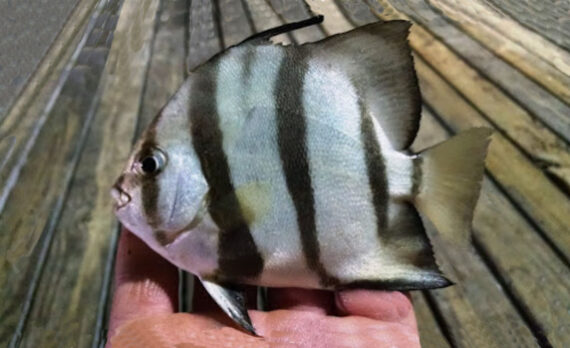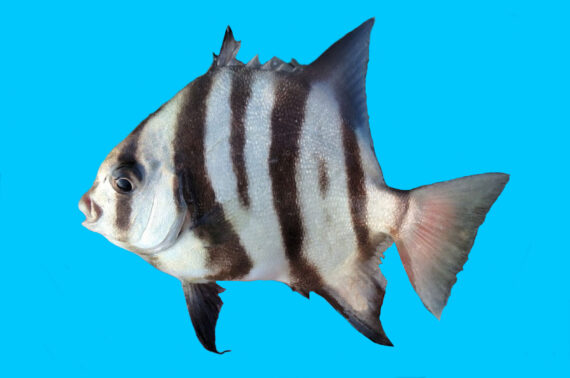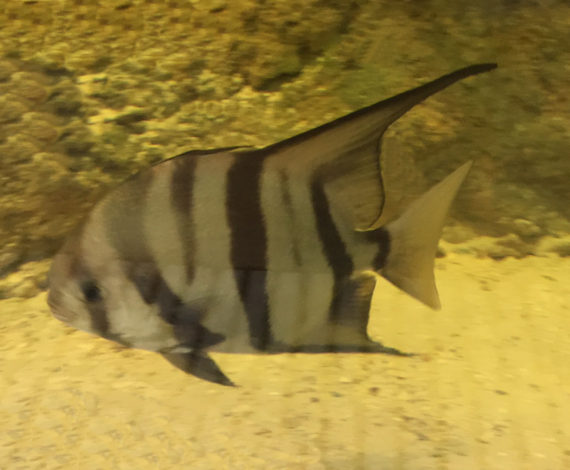Atlantic Spadefish, Chaetodipterus faber
 Atlantic Spadefish, Chaetodipterus faber. Fish caught from coastal waters off Tampa, Florida, May 2018. Length: 17.5 cm (6.9 inches). Catch, photograph, and identification courtesy of Ben Cantrell, San Diego, California.
Atlantic Spadefish, Chaetodipterus faber. Fish caught from coastal waters off Tampa, Florida, May 2018. Length: 17.5 cm (6.9 inches). Catch, photograph, and identification courtesy of Ben Cantrell, San Diego, California.
 Atlantic Spadefish, Chaetodipterus faber. Fish caught from the 61st Street Fishing Pier, Galveston, Texas, September 2015.. Length: 17.5 cm (6.9 inches). Catch, photograph and identification courtesy of Marc Eberlein, Grand Rapids, Michigan.
Atlantic Spadefish, Chaetodipterus faber. Fish caught from the 61st Street Fishing Pier, Galveston, Texas, September 2015.. Length: 17.5 cm (6.9 inches). Catch, photograph and identification courtesy of Marc Eberlein, Grand Rapids, Michigan.
 Atlantic Spadefish, Chaetodipterus faber. Fish caught off the Tybee Pier, Savannah, Georgia, October 2009. Length: 20.0 cm (7.9 inches). Catch, photograph, and identification courtesy of Kenneth Tse, Toronto, Canada.
Atlantic Spadefish, Chaetodipterus faber. Fish caught off the Tybee Pier, Savannah, Georgia, October 2009. Length: 20.0 cm (7.9 inches). Catch, photograph, and identification courtesy of Kenneth Tse, Toronto, Canada.
 Atlantic Spadefish, Chaetodipterus faber. Fish caught from coastal waters off North Carolina. Length: 20.0 cm (7.9 inches). Catch, photograph, and identification courtesy of Josh Leisen (joshadventures.com), Gaylord, Michigan.
Atlantic Spadefish, Chaetodipterus faber. Fish caught from coastal waters off North Carolina. Length: 20.0 cm (7.9 inches). Catch, photograph, and identification courtesy of Josh Leisen (joshadventures.com), Gaylord, Michigan.
 Atlantic Spadefish, Chaetodipterus faber. Aquarium fish photographed in the Rookery Bay National Estuarine Research Reserve, Naples, Florida, January 2019.
Atlantic Spadefish, Chaetodipterus faber. Aquarium fish photographed in the Rookery Bay National Estuarine Research Reserve, Naples, Florida, January 2019.
The Atlantic Spadefish, Chaetodipterus faber, is a member of the Spadefish or Ephippidae Family, that is known in Mexico as chabela. Globally, there are three species in the genus Chaetodipterus, of which two are found in Mexican waters, one in the Atlantic and one in the Pacific Ocean.
The Atlantic Spadefish has a highly compressed deep oval body with a depth that is 83% to 87% of standard length. They are silvery white to grayish with 6 blackish wide vertical bars on their body that extend into their fins and tend to fade with age. Juveniles are coppery brown with irregular dark bars and scattered dark spots. Their fins are dark except in the areas where the white background extends into. Their head is rounded with a very short blunt snout and a small mouth that opens at the front with small brush-like teeth in bands. Their anal and dorsal fins are similar in shape with pointed tips. Their anal fin has 3 spines and 18 or 19 rays; their caudal fin is slightly concave; their first dorsal fin has 9 spines, the third spine being significantly longer; their second dorsal fin has 21 to 23 rays; and, their pectoral fins are short; and their pelvic fins are long and under the pectoral fins. They are covered with scales. They have a complete lateral line.
The Atlantic Spadefish inhabits a variety of habitats collecting in large schools of up to 500 individuals and are found around man-made structures including bridges, buoys, harbors, pilings, and wrecks. They can also be found around reefs and within mangroves from estuaries to the open ocean at depths up to 40 m (130 feet). They reach a maximum of 91 cm (3 feet 0 inches) in length and 9.1 kg (20 lbs) in weight. As of January 1, 2024, the International Game Fish Association world record stood at 6.75 kg (14 lbs 14 oz) with the fish caught in coastal waters within Chesapeake Bay, Virginia in June 2009. They feed on algae and a variety of benthic and planktonic invertebrates including crustaceans, mollusks, and worms. In turn they are preyed upon by sharks and large fish including tripletail. Reproduction is oviparous with each female releasing 1,000,000 eggs annually. The eggs are small and buoyant and hatch within twenty-four hours. They have lifespans of up to ten years.
The Atlantic Spadefish is a resident of all Mexican waters of the Atlantic Ocean including the Gulf of Mexico and the east coast of the Yucatán Peninsula in the Caribbean.
The Atlantic Spadefish can be confused with the Banded Butterflyfish, Chaetodon striatus (4 bars; white fin margins), the Orbiculate Batfish, Platax orbicularis (4 bars; a native to the Pacific but thought to have been introduced to the Atlantic via aquarium release) and the Sheepshead, Archosargus probatocephalus (longer snout; more elongated body profile; smaller anal and dorsal fins).
From a conservation perspective the Atlantic Spadefish is currently considered to be of Least Concern with stable widely distributed populations. They are fished commercially, but not extensively, and marketed fresh. They are considered a quality food fish, however, they are known to contain ciguatoxin. They are considered a good recreational angling foe being classic nibblers and difficult to hook. They are known to approach divers and they are also a component of the aquarium trade.